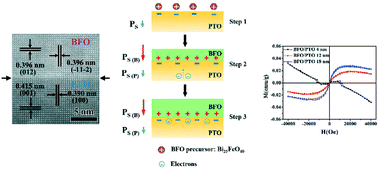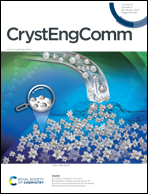Polarization screening-induced epitaxial growth and interfacial magnetism of BiFeO3/PbTiO3 nanoplates†
Abstract
In this work, single-crystal BiFeO3/PbTiO3 (BFO/PTO) nanoplates have been successfully synthesized via a hydrothermal method. It is interesting to find that BFO films selectively grew on the negative polar surface of PTO nanoplates with a saturation thickness of about 18–20 nm. Below such saturation size, the thickness of BFO films can be controlled in the range of 4–18 nm. An atomically sharp interface was identified to be formed between BFO and PTO with an epitaxial relationship of {012}BFO//{001}PTO. In particular, a room-temperature ferromagnetism in the nanoplates has been observed, where the saturation magnetization significantly decreased from to 0.029 to 0.003 emu g−1 upon the film thickness decreasing to 4 nm. Electron energy-loss spectroscopy (EELS) analysis on the interface suggests that the positive polar surface of BFO could be screened by both of the negative polarization and addition electrons in PTO. A mechanism of “screening balance broken and rebuilt” on the negative interface was proposed to explain the existence of selective growth, the saturation thickness and magnetism of the nanoplates. The findings suggest that a polar surface could be a powerful platform to realize the controllable epitaxial growth of perovskite oxide heterostructures with the intriguing interface functionality.



 Please wait while we load your content...
Please wait while we load your content...